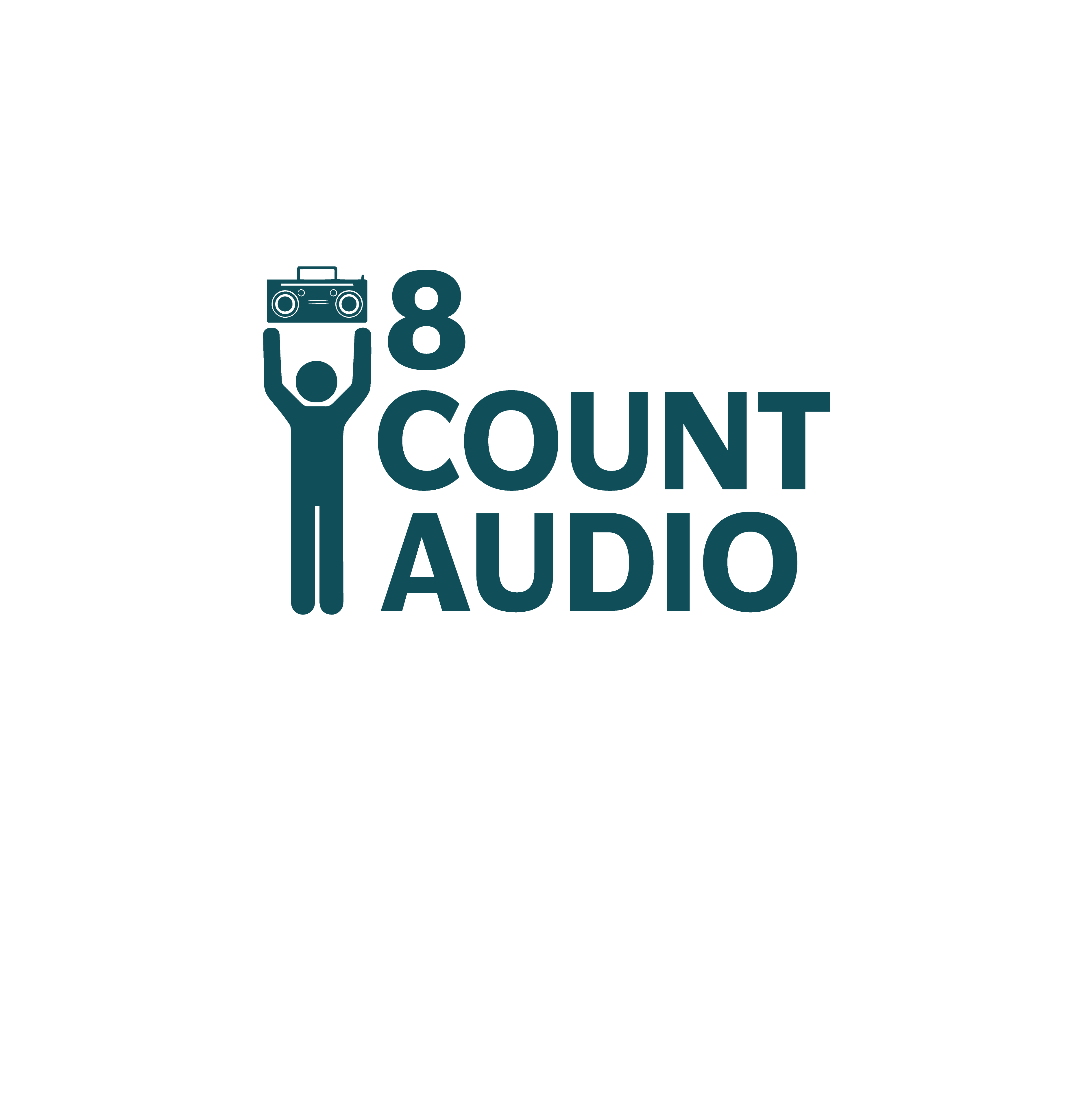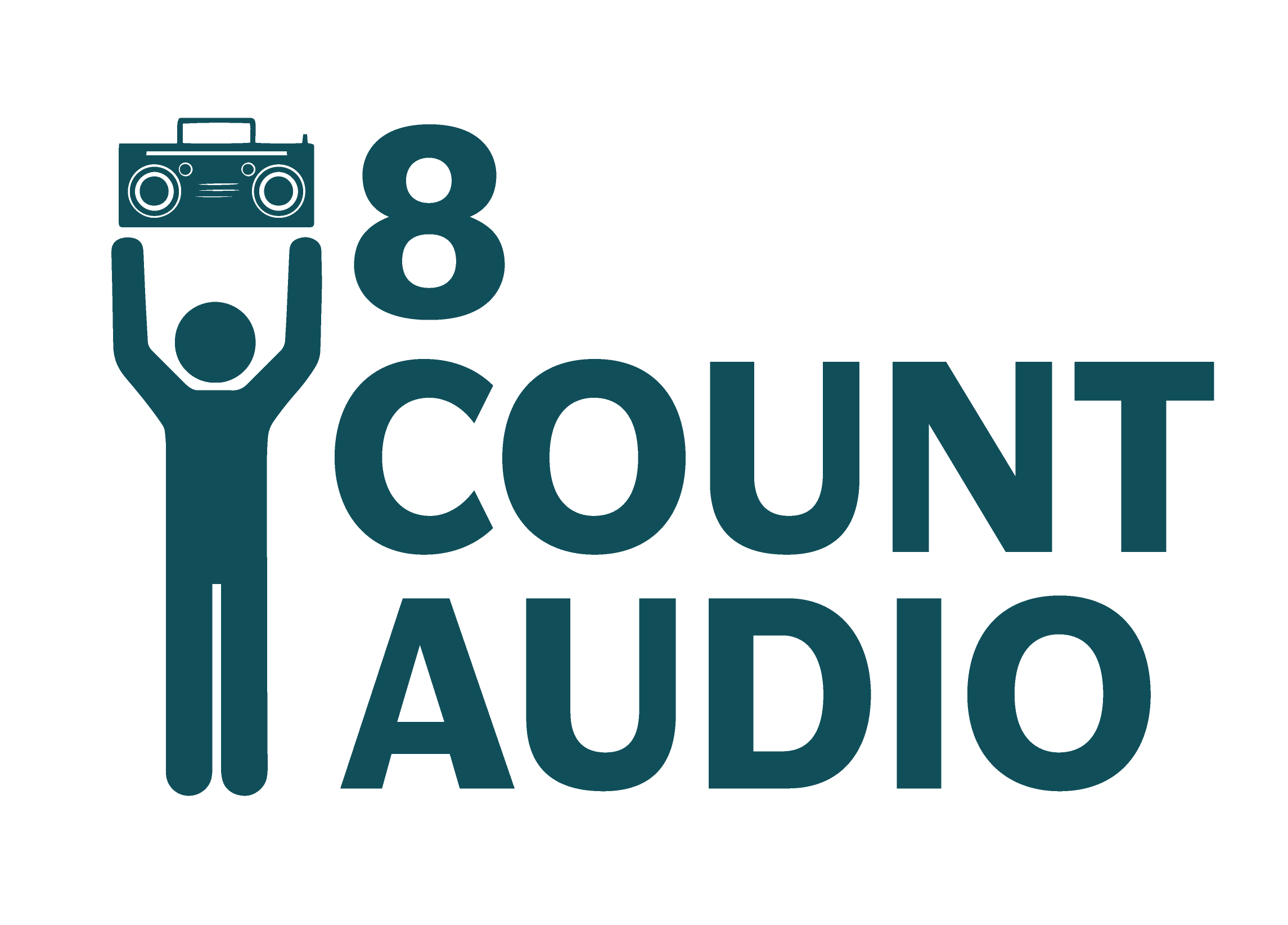Playlist: 8 Car Songs Part 1
by Norm Ramil, 8 Count Audio creative.director / chief.music.officer / dance.fan
Got another musicality playlist for ya! A lot of us are on the road this summer–dance camps, family vacays, and of course the 8 Count Audio Summer Tour. So this time I’ve got 8 car songs that cover lots of different styles and territories.
BTW: You’ll need the free Spotify app to hear these songs in their entirety–the times that I list won’t line up with the 30 second preview versions of these songs!
Fifth Harmony “Top Down”: Well, first you’d have to edit out that first lyric. But besides that, you’ve got a sassy, mid-tempo car song! Check out the sparse instrumentation in the intro–just that bass synthesizer (with a cool filter that almost gives it a vocal quality) and the finger snaps. You could maximize musicality by planning your hits to match the rhythm of that melody (0:00-0:05).
The first big transition is from the end of verse 1 into the chorus–there’s a slow, upward “ahhh” in the background vocals, and you’ll want to use a slow movement to accentuate that (0:45-0:47). Another quick transition is marked by 3 quick drum hits on count-8, right at 1:05 and leading into the “electric city” section. You might hear that saxophone part, and it’s almost got a squirrelly sound to it, so a lot of hip hop iso movements would fit in well.
1:35 starts an interesting section where the musical parts mostly drop out and a whole new drum sound shows up, so here’s a good place to temporarily shift the vibe of your choreo for a couple 8-counts. Yet another ear-catching moment is the end of the 2nd “electric city” section: right at 2:20-2:22, every instrument disappears and it’s just the vocal going, “I think that I might stay.” Possibly a good time for either a whole-team freeze or a soloist.
And speaking of that “electric city” section, it almost sounds like that should be the title of the song! You’ll often run into situations where a song title suggests your theme, but the actual chorus doesn’t hit your theme that hard, and possibly even takes you in a whole ‘nother direction. So you could think of this song as useable for your next electricity mix, or if for a driving theme, you’d have to keep a lot of the verse where they actually sing about driving.
Tegan and Sara “Drove Me Wild”: Counting their latest album that dropped in June, this sister combination has released 8 albums. They remain the darlings of the indie-pop scene and this insanely catchy track from 2013 underscores their sonic appeal. Musically you’ll hear a seamless blend of synth-pop and guitar-driven indie rock. The vocals have a slightly airy feel that’s exacerbated by all that indie reverb that’s so stylish right now (reverb is that echo-ish effect that sounds like you’re singing in an empty gym).
Dancers use prep counts but so do entire bands, and this time, it’s the bass player who marks count-8 at 0:00. Then you get that catchy keyboard part that reappears a couple more times in the song—something we usually call “the hook.” It’s sort of buried during the chorus because you don’t want it to fight with the vocals, but it gets the spotlight again at 2:44 and 3:39 (it might be a good idea to repeat similar choreo in all 3 sections).
Notice the clever contrast between the full sound of the intro (0:00-0:15) and verse 1 where they strip back all of the instruments (it’s just a bass drum on each count, a light hi-hat, and a guitar). Any choreo would want to highlight that difference. For the second half of verse 1, you’ll want to intensify the dance because at 0:30, the snare drum comes in along with a new, growly keyboard in the right speaker.
Verse 2 has its own new tricks that open up things for a choreographer. You get a soft cool-down section after the chorus (1:07-1:14) that you could potentially cut in half to save time. As opposed to verse 1, that snare drum is present for the entire 2nd verse (which starts at 1:15). At 1:19 the syllables for “tangled” get repeated, and the same technique happens again for “I got” a few seconds later—definitely a chance to do something cool. From 1:30-1:44 (the second half of verse 2) you hear the bass play a more complex, upbeat part for the first time in the song and it really gives a sense of increased movement without ever changing the tempo or volume. Subtle but really effective. What would you do to have the choreography evolve here compared to 1:15-1:29?
Lastly, let’s say you’re using this for a car / transportation theme. Tegan and Sara are using “drive” in the metaphorical sense, and you get some nice references to driving with “swerving” and the relationship being “stalled,” and not losing “control” (all of these come during the bridge from 2:14-2:43). So it’ll be up to you how literal you want to be with your theme—are you sticking with car songs or are you willing to use a “drive” song that’s not actually about driving?
Oh yeah—how ‘bout that sweet break with the keyboard playing the song’s musical theme from 2:44-2:48? What a cool way to link the end of the bridge to the final chorus—lots of contrast in intensity. Tempo: 130 BPM.
Kanye West, Big Sean, Pusha T, 2 Chainz “Mercy”: The summer of 2012 was the high point of hip hop’s “trap” sound. Don’t get me wrong—trap is still a force, but this moment was when it was fresh with max impact. Trap beats have lots going on in terms of extra hi-hat and snare hits, crammed into 16th and 32nd-notes over a really slow tempo (it’s that extreme contrast between fast notes on top of a slow tempo that makes it so dynamic). Trap hip hop also leans heavily on an overall creepy, haunting sound pushed by a keyboard motif—something like what you’d hear in a cheesy ‘80s horror flick, and really fitting if you’re creeping your ride through a sketchy neighborhood.
The track starts with a sampled vocal that’s deliberately hard to make out. It’s a typical Kanye move to mess with a vocal sample’s pitch, and it creates a vivid contrast to the clarity of the raps in the verse and chorus.
Kanye also hits you with that creepy keyboard riff right away—it sticks around for all the choruses and reverbs. When the speech sounds like the word “live” (it’s actually the second syllable to “believe”), it repeats, so I can see the kind of choreo that expands on the first “live” and then reverses itself on the second one. Maybe a very controlled arm extension and contraction. The stuttered “O.K.” is also a great spot to do something cool based on the rhythm of that vocal effect (0:13-0:14 and again throughout the track).
That unrelenting keyboard riff haunts you through almost every 8-count of the track. Until it doesn’t. That’s the bridge that hits at 3:13, and the sudden difference is like night and day. The tempo feels faster but it’s not—the bass part plays steady 16th notes to merely suggest it’s faster. But of course, dancers should think faster and approach this in terms of double-counts. Make sure you’ve got some extremely different combinations set for that change, and then a way to return to your original choreo ideas when the bridge ends and the last verse starts (4:08).
Not to say that you shouldn’t double count the whole thing (this track’s 70 beats per minute). Trap is about fast, complicated drums parts on top of a slow tempo. You’ve got a lot of freedom to double count some song sections and not others. In fact, think about how cool it would look to count one line at 140 BPM and then the following line at 70 BPM (in half), or vice versa!
Billy Ocean “Get Outta My Dreams, Get Into My Car”: Alright, you get the free car engine starting sound effect right at 0:00, so that’s already a bonus right there.
Plenty of late ‘80s pop ideas at play here. The long intro drum section is sparse so that the (cheesy) vocal storyline can take centerstage (0:17-0:24). Right after that are 2 quick drum hits that equal awesome choreo hits, especially because the 2nd one is syncopated (it’s halfway between an “and” count and a numbered count, or on a 16th-note if you’ve got musical training). Then the extra loonnngggg “oh” to “ow” with more drum hits to easily choreograph to (0:27-0:31)!
A slight challenge shows up next—the musical intro (0:32-0:48) takes up lots of precious seconds. You could easily cut out a chunk off the end of this section, but it’s tough to let go of all those catchy chords. The same problem arises with those long choruses (1:21-2:00), but usually pop songs are pretty forgiving if you want to cut sections in half.
Now to make something out of those cheesy ‘80s lyrics (0:48-1:21)! Anytime you get a question like “who’s that lady” and “who’s that woman,” you may want to have to groups—one looking like they’re posing the question, looking at the other group posing as the answer. A lot of the concrete images can translate into pom pictures (“sun,” “Cinderella,” “shoe”) or, even better, group movements that show the sun shining and Cinderella stepping into that shoe. It’s usually better to show the story rather than just tell it.
You can also highlight the chorus’ idea of getting out of something and getting into something else by stepping through some kind of barrier. The classic call-and-response technique (“hey, hey, you, you” from 1:47-1:48) should be mimicked in whatever’s going on in the choreo at that point.
One last note on editing for time: you’ll have to manage that key change that hits at 3:56. You’ll want to include that little transition from 3:53-3:58. Luckily, it’s pretty clear-cut and the key change will sound sensible but only if you include that transition! You can skirt around this problem by just using one of the earlier choruses to end the song instead of using the actual final chorus…this might make sense since the song fades out and you might not be comfortable editing fades. Tempo: a very ’80s 116-117 BPM.
Taio Cruz “Fast Car”: This was released as a single but wasn’t much of a hit. The entire song’s full of car and driving references that you can play around with at a friendly and familiar 129 BPM (which you might speed up depending on your team and your choreography ideas).
A dainty, almost lyrical intro starts us off with a nice acoustic guitar part (0:03-0:24) before the bass drum arrives. This approach returns again for verse 2 and verse 3. On a more subtle note, you could take advantage of the little hit at 1:16 that marks the line between the first and second half of the verse.
The initial chorus drops the bass drum’s strict tempo and you suddenly have a half-tempo feel before the full beat resumes at 0:55. The usual music trick to ease that transition is a sharp drum hit, and you get this on count 8 right after the “go-go-go” at 0:54. You also have a shot at breaking out any ripple tricks they’ve got stored on the shelf for “turn me on, on, on, on” and “make my engine run, run, run run!”
The bridge (2:09-2:23) introduces an ascending keyboard part that keeps going up, up, up on a syncopated rhythm (focusing on the “AND-counts”). It’s on the quiet side, but I bet judges would appreciate any team that pulls out this subtle piece of musicality and highlights it on the floor. The second bridge (this time it’s more of a quiet “break” from 2:23-2:53, or you could even think of it as the 3rd verse) sounds a lot like the intro, and you may want to bring back elements from that earlier choreo to use here.
Twenty One Pilots “Car Radio”: These guys are pretty much in charge of the pop / alt-rock sound of 2016. One interesting twist is that you can approach this from a hip hop mindset if you want, not just because of the tempo (65 BPM or 130 if you want to double-count) but because of the spoken-vocal style.
You can shift to an upbeat jazz or pom vibe at 2:42 when the steady bass drum kicks in. The steady keyboard 8th-notes in your right speaker also suggest that a change in rhythmic feel is happening, and it’s gonna be confirmed at 2:57. Don’t forget to give a nod to the little drum fill that covers the transition right at 2:56—it’s technically count # 8.
At this point the track is in full-on “anthem” mode, and the crowd would be jumping in the club or festival from 2:57 onwards. Check out the anthemic “ohhhhs” at 3:13 and 3:17. They don’t come right on count-1 which adds a bit of the unexpected, and it’s a great moment to use some lifts to highlight the vocals. Things quiet down starting at 3:26, yet they crank up the intensity with some screamo vocals. I see a soloist sitting alone as a group frenetically moves around her.
One final cool opportunity is that count of silence at 3:57 (actually, there’s a single snare drum hit right at that moment). It’s like an exclamation point to the screamed line, “And now I just sit!” The music shifts back to the original sound of the track, and it’s such a stark contrast to the chaotic energy that just came before it. This final section serves as a return to order, so it’s a good time to shift back to more orderly choreography that wraps the whole routine up in a tidy way.
Tracy Chapman “Fast Car”: This song won her a Grammy in 1988, but in these modern times where more people than ever are concerned about social justice issues, these lyrics can still carry plenty of weight. It’s possible to remix this one, but this song is at its best as a smart, lyrical dance.
Once again the band gives you a cue before the main intro starts—those hi-hats hit on counts 7 and 8, and then we move on to that memorable acoustic guitar line. I wrote about triplets in the last playlist, and here they are again, waiting for a choreographer to use them (0:13-0:15). It’s the idea of 3 notes played evenly over the space of 2 counts, so you get kind of a staggered feel.
The lyrics are a mix of tragedy and desperate hope, so you’ll want to channel that. For high school dance teams, it would definitely impress judges to tackle the kind of lyrical emotion in this type of theme that you just don’t get in a song about breakups or death. The narrator believes there’s a plan, there’s a way out of here. Success isn’t likely, but that glimmer of light is peeking through the clouds.
Each verse and section has straightforward instrumentation, so that makes it pretty easy to cut up and take out parts for time. But you’ll absolutely want to keep the bridge, which shows up twice in the song (2:01 and then at 3:55) where the drums add some energy. It matches the change in lyrical tone since the narrator spends these sections looking back at happier times. This section ends with the repeated phrase “be someone, be someone,” so some kind of sophisticated mirroring or rippling would work well. It might be cool to accentuate the comma in that line–hit hard and hold it for a count. You’ll also want to use the actual ending of the song where that single snare drum hit at 4:49 puts a period on the story. BPM is around 104-105.
Cassadee Pope “This Car”: Country music is overflowing with songs about cars, trucks, and wheeled agricultural vehicles (as in, “She Thinks My Tractor’s Sexy”). This intro has a long “whoa-oh-oh” but also, quietly, a short pair of “oh, ohs” at 0:07. It’s a little tricky because these come on the AND counts of 7 and 8. This returns at 0:14 but this time you get three of them: the AND counts of 6, 7, and 8.
Verse 1 starts with the imagery of “two kids holding hands…” and that’s a pretty clear signal for even the newest choreographers out there. But you can get creative—do you want to literally show two soloists portraying these words, or do you try something more abstract with partner work throughout the whole formation?
The section at 0:31 could be thought of either as the second half of the verse or the pre-chorus. The lines that go, “You’d do anything to make me laugh…” have a staggered feel. They’re not actually triplets, because the notes aren’t spaced equally from each other—but they are syncopated, meaning a lot of the energy falls on the AND counts. This happens again in the next line at 0:38. Designing a movement to flow with that melody’s rhythm instead of just plugging in a combination that works over any 8-count is a core idea in musicality!
It’s pop country, but the tempo’s set at 127 BPM, which is a pretty standard EDM beat. You could easily take some choreo ideas you’ve saved up for an EDM song and adapt them to this song!


